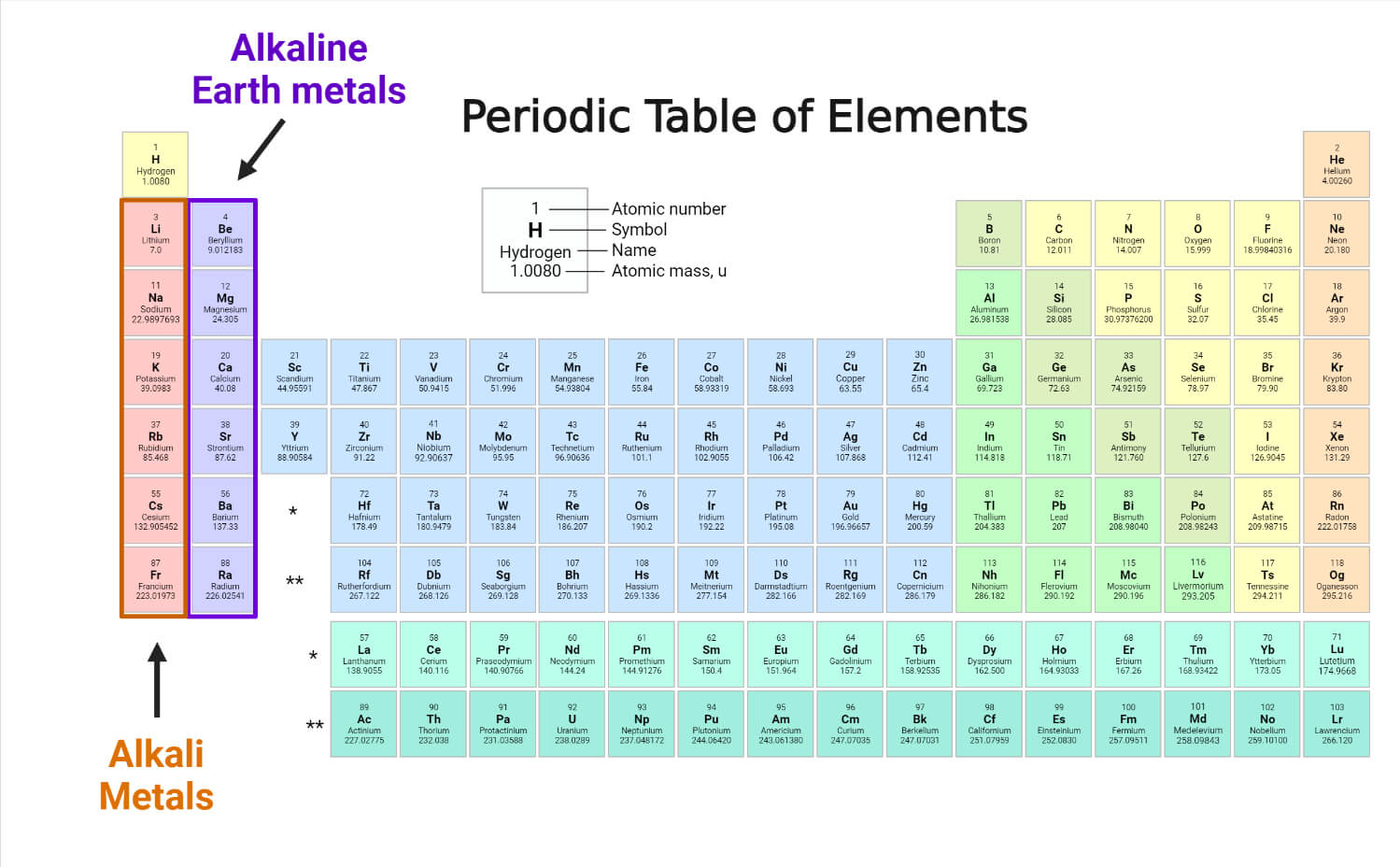Interesting Science Videos
What are Alkali metals?
Elements of group IA are called alkali metals. The word alkali is derived from the Arabic word alquli, meaning ashes of plants, because the plant ashes are particularly rich in sodium and potassium carbonates. In the periodic table, they are placed in s-block, so-called s-block elements. Their outermost electronic configuration is ns, i.e., The s-subshell consists of only one electron. They are highly reactive and are not found in a free state.

What are Alkaline earth metals?
Elements of group IIA are called alkaline earth metals. The oxides of these metals are similar to those of alkali metals and exist on earth, which withstands high temperatures. So these elements are called alkaline earth metals. All these elements belong to the s-block with a general configuration of ns2. They are also reactive elements and are not found in a free state.
Similarities between Alkali and Alkaline Earth Metals
1. Both metals are found in combined form, not in a free state.
2. they tarnish in moist air.
3. Both of them are obtained through the process of electrolysis from their fused chlorides.
4. They decompose on water liberating hydrogen gas and forming an alkaline solution of their hydroxides.
5. They are soft silvery white.
6. they are reducing in nature.
7. They are electropositive.
8. All combine with hydrogen, forming a hydride.
9. Their oxides are white and remain unchanged on heating and give hydroxide with water.
10. They combine with Cl2, Br2 and I2 easily.
20 Differences between Alkali and Alkaline earth metals
Although they are S-block elements, they have some different properties. The differences between alkali and alkaline earth metals are:
| Alkali metals | Alkaline Earth Metals |
| 1. They are soft metals. | 1. They are relatively harder than alkali metals. |
| 2. They have one valence electron. | 2. They have two valence electrons. |
| 3. Alkali metals exhibit an oxidation state of + 1 only. | 3. Alkaline earth metals exhibit an oxidation state of +2 only. |
| 4. They have lower ionization energy. | 4. They have higher ionization energy than alkali metals. |
| 5. Alkali metals are more reactive than alkaline earth metals. | 5. They are less reactive than alkali metals. |
| 6. They have an electronic configuration of [noble gas]ns1. | 6. 6. They have an electronic configuration of [noble gas]ns2. |
| 7. Their melting point is low. | 7. Their melting point is high. |
| 8. They are lighter than water and have low specific gravity. | 8. They are heavier than water but have low specific gravity. |
| 9. Except lithium, no other alkali metals combine with nitrogen. | 9. All these metals combine with nitrogen to form corresponding nitrides. |
| 10. They decompose water more energetically. | 10. They decompose in water less energetically than alkali metals. |
| 11. Alkali metals react with ammonia to form amides. | 11. They react with ammonia at low temperatures to form hexamines. |
| 12. All metal sulfates are soluble in water. | 12. Except for Be and Mg, the sulfates of other alkaline earth metals are insoluble in water. |
| 13. At room temperature, bicarbonates of alkali metals exist in solid form. | 13. At room temperature, bicarbonates of alkaline earth metals exist in solution form. |
| 14. Oxides of alkali metals are very basic. | 14. Oxides of alkali metals are not as basic as those of alkali metals. |
| 15. They are highly electropositive. | 15. They are less electropositive. |
| 16. Their sulfates form alums with trivalent metal sulfates. | 16. Their sulfates do not form alums. |
| 17. Except for Li, alkali metals do not form complex compounds. | 17. Alkaline Earth Metals can form complex compounds. |
| 18. Except for Li2CO3, their carbonates are water-soluble. | 18. Carbonates of alkaline earth metals are water-soluble. |
| 19. Hydroxides are strongly basic. | 19. Hydroxides are less basic. |
| 20. Except Li, other alkali metal nitrates evolve NO2 on heating. | 20. All alkaline earth metal nitrates produce NO2 on heating. |
References
- Lee J. D. (1977). A new concise inorganic chemistry (3d ed.). Van Nostrand Reinhold. Retrieved August 28 2022 from https://archive.org/details/newconciseinorga00leej.
- https://www.differencebetween.com/difference-between-alkali-metals-and-vs-alkaline-earth-metals/.
- https://pediaa.com/difference-between-alkali-metals-and-alkaline-earth-metals/
- https://askanydifference.com/difference-between-alkali-and-alkaline-2/.
- https://euresisjournal.org/difference-between-alkali-metals-and-alkaline-earth-metals.
- https://www.technologyuk.net/science/matter/alkali-and-alkali-earth-metals.shtml.
